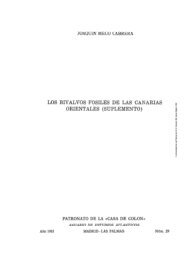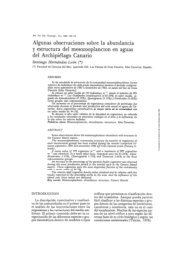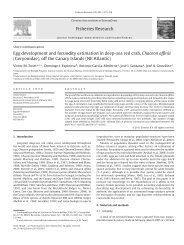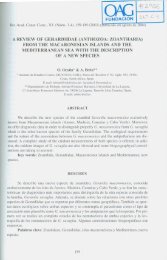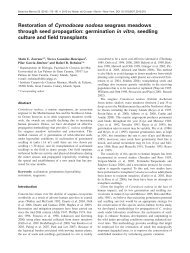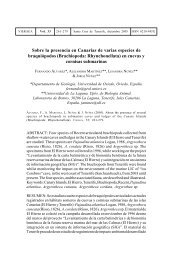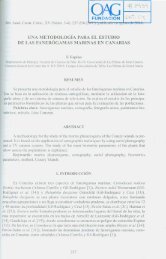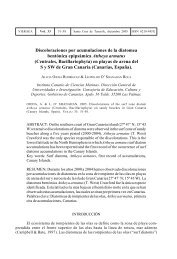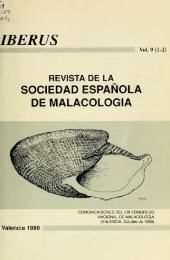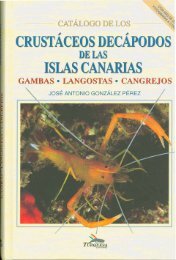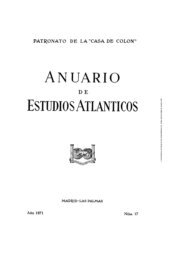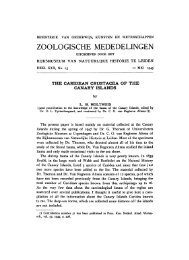of the madeira and selvagens archipelagos - redmic
of the madeira and selvagens archipelagos - redmic
of the madeira and selvagens archipelagos - redmic
You also want an ePaper? Increase the reach of your titles
YUMPU automatically turns print PDFs into web optimized ePapers that Google loves.
dos casos, o componente fúngico pertence ao grupo dos<br />
Ascomycota e, só em alguns casos, ao dos Basidiomycota<br />
ou ao dos Deuteromycota. Esta simbiose permite que<br />
o líquene sobreviva em habitats onde nenhum dos seus<br />
constituintes conseguiria sobreviver sozinho, sendo possível<br />
observar os líquenes em quase todos os ecossistemas<br />
terrestres, sobre uma elevada diversidade de substratos,<br />
como solo, rochas, árvores ou, inclusivamente, no dorso de<br />
insectos ou superfícies artificiais, como sinais de trânsito.<br />
Nesta associação, o fotobionte tem como principal função<br />
realizar a fotossíntese, produzindo os hidratos de carbono<br />
necessários à manutenção da simbiose, enquanto o fungo<br />
(micobionte) fornece essencialmente o suporte e a protecção<br />
em condições de luz e temperatura demasiado intensas. Algumas<br />
espécies mostraram serem capazes de resistir às condições<br />
extremas do espaço, resistindo à exposição extraterrestre<br />
de radiação ultravioleta e cósmica (Sancho et al. 2007).<br />
Os líquenes apresentam características morfológicas e<br />
ecológicas peculiares que lhes conferem uma importância<br />
crescente em programas de biomonitorização e conservação<br />
ambiental, nos quais são utilizados como indicadores<br />
ecológicos, de poluição atmosférica, de estabilidade de habitats<br />
naturais ou mesmo como indicadores paleológicos<br />
(Nimis et al. 2002).<br />
Do ponto de vista ecológico, os líquenes desempenham<br />
um papel fundamental na colonização e estabilização dos<br />
solos, integr<strong>and</strong>o as crostas biológicas do solo (Belnap et<br />
al. 2001), no controlo da erosão, na produção de biomassa<br />
e na reciclagem de nutrientes, para além de serem utilizados<br />
como habitat ou como principal fonte de alimento de<br />
diversos animais.<br />
2. Metodologia<br />
Este trabalho tem como objectivo produzir uma lista de<br />
referências dos líquenes e fungos liquenícolas dos arquipélagos<br />
da Madeira e das Selvagens, com base na literatura<br />
existente, actualiz<strong>and</strong>o e aument<strong>and</strong>o as publicações de<br />
Hafellner (1995, 2002, 2005).<br />
A lista apresentada inclui apenas os taxa com categoria<br />
taxonómica igual ou superior à da subespécie. Os taxa<br />
abaixo do nível de subespécie não foram considerados,<br />
sendo porém referenciados no índice, juntamente com os<br />
sinónimos das espécies referidas.<br />
Na lista florística apresenta -se a distribuição das espécies<br />
ou subespécies nas quatro áreas dos arquipélagos<br />
da Madeira e das Selvagens, utiliz<strong>and</strong>o a seguinte simbologia:<br />
M (Madeira), PS (Porto Santo), D (Desertas) e S<br />
(Selvagens). Para os taxa relativamente aos quais se desconhece<br />
a área em que foram observados, utilizou -se o<br />
símbolo MA. Na primeira coluna estão assinalados (como<br />
END) os endemismos, isto é, os taxa que até ao momento<br />
são apenas conhecidos nestes dois arquipélagos.<br />
A nomenclatura utilizada foi baseada em Nimis (1993,<br />
2005), Cabi Bioscience et al. (2005) e Llimona & Hl<strong>and</strong>un<br />
(2001). O arranjo das classes, ordens e famílias foi baseado<br />
em Eriksson (2006).<br />
96<br />
when <strong>the</strong>y develop in isolation from each o<strong>the</strong>r. In <strong>the</strong> majority<br />
<strong>of</strong> cases, <strong>the</strong> fungal component is an Ascomycota,<br />
although infrequently Basidiomycota or Deuteromycota can<br />
be involved.<br />
This symbiotic association enables <strong>the</strong> lichens to survive<br />
in habitats where nei<strong>the</strong>r <strong>of</strong> <strong>the</strong> constituents could survive<br />
on <strong>the</strong>ir own <strong>and</strong> in most terrestrial ecosystems it is possible<br />
to find lichens growing on a high diversity <strong>of</strong> substrates;<br />
soil, rocks, trees <strong>and</strong> even <strong>the</strong> backs <strong>of</strong> insects or artificial<br />
surfaces such as traffic signs.<br />
The main function <strong>of</strong> <strong>the</strong> photobiont is to carry out photosyn<strong>the</strong>sis,<br />
producing <strong>the</strong> necessary carbohydrates for<br />
maintaining <strong>the</strong> fungus, while <strong>the</strong> micobiont is responsible<br />
for <strong>the</strong> structure <strong>of</strong> <strong>the</strong> thallus <strong>and</strong> its reproduction, besides<br />
protecting <strong>the</strong> photobiont from excessively high levels <strong>of</strong> light<br />
<strong>and</strong> heat. Some species have been shown to be able to<br />
survive <strong>the</strong> extreme conditions in space, resisting to extraterrestrial<br />
UV <strong>and</strong> cosmic radiations (Sancho et al. 2007).<br />
The lichens demonstrate morphological <strong>and</strong> ecological<br />
characteristics that make <strong>the</strong>m <strong>of</strong> great importance to monitoring<br />
programmes <strong>and</strong> environmental conservation. In<br />
<strong>the</strong>se, <strong>the</strong>y are used as biological indicators <strong>of</strong> air pollution,<br />
ecosystem stability, <strong>and</strong> even as paleological indicators (Nimis<br />
et al. 2002).<br />
From an ecological point <strong>of</strong> view, <strong>the</strong> lichens play a fundamental<br />
role in <strong>the</strong> colonisation <strong>and</strong> stability <strong>of</strong> soils: as<br />
a component <strong>of</strong> biological soil crusts (Belnap et al. 2001),<br />
in controlling erosion, in biomass production <strong>and</strong> mineral<br />
cycling, while <strong>the</strong>y are also used as habitats <strong>and</strong> food sources<br />
for a large variety <strong>of</strong> animals.<br />
2. Methodology<br />
This work aims to produce a bibliographic checklist <strong>of</strong> lichens<br />
<strong>and</strong> lichenicolous Fungi <strong>of</strong> <strong>the</strong> Madeira <strong>and</strong> Selvagens<br />
<strong>archipelagos</strong>, based on existing references, updating <strong>and</strong> supplementing<br />
those published by Hafellner (1995, 2002, 2005).<br />
The list shown includes only <strong>the</strong> taxa with ranks equal or<br />
higher than subspecies level. O<strong>the</strong>r taxa with lower ranks<br />
were not included; however, <strong>the</strong>y are referred to in <strong>the</strong> index<br />
toge<strong>the</strong>r with synonyms <strong>of</strong> <strong>the</strong> cited species.<br />
In <strong>the</strong> floristic list <strong>the</strong> species’ distribution in <strong>the</strong> four areas<br />
<strong>of</strong> <strong>the</strong> <strong>archipelagos</strong> <strong>of</strong> Madeira <strong>and</strong> Selvagens is presented,<br />
using <strong>the</strong> following symbols: M (Madeira), PS (Porto Santo),<br />
D (Desertas) <strong>and</strong> S (Selvagens). For <strong>the</strong> taxa <strong>of</strong> which <strong>the</strong> distribution<br />
within <strong>the</strong> <strong>archipelagos</strong> <strong>of</strong> Madeira <strong>and</strong> Selvagens<br />
is unknown, <strong>the</strong> symbol MA is used. In <strong>the</strong> first column, <strong>the</strong><br />
endemic species for <strong>the</strong> <strong>archipelagos</strong> <strong>of</strong> Madeira <strong>and</strong> Selvagens,<br />
at <strong>the</strong> level <strong>of</strong> current knowledge, are marked with END.<br />
The taxa names were based on Nimis (1993, 2005), Cabi<br />
Bioscience et al. (2005) <strong>and</strong> Llimona & Hladun (2001). The<br />
taxonomic hierarchy <strong>of</strong> classes, orders <strong>and</strong> families follows<br />
Eriksson (2006).<br />
The floristic list <strong>of</strong> lichenized Fungi was compared with<br />
that <strong>of</strong> <strong>the</strong> o<strong>the</strong>r Macaronesian <strong>archipelagos</strong> <strong>of</strong> Cape Verde<br />
(Sánchez -Pinto & Rodríguez 2005), <strong>the</strong> Canary Islan-



